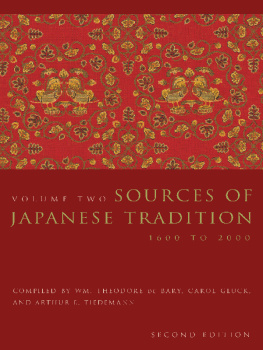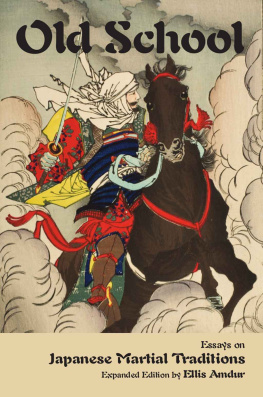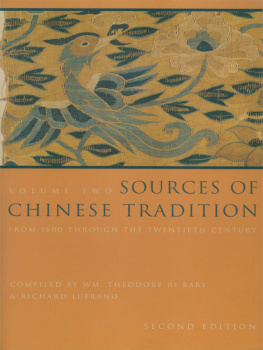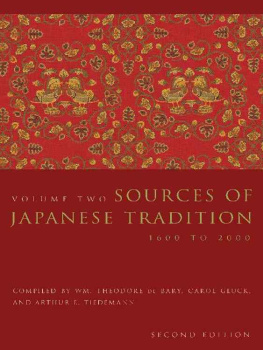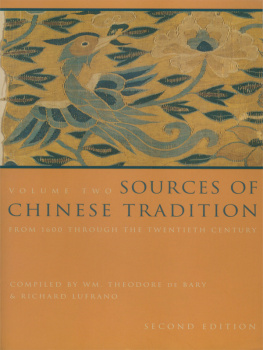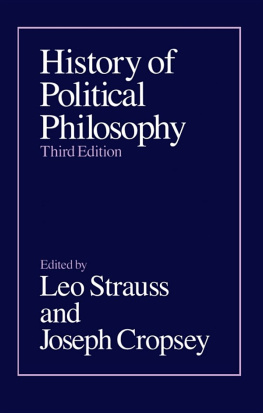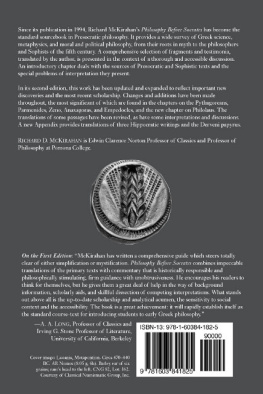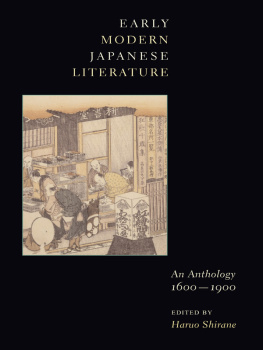Sources of Japanese Tradition
SECOND EDITION
VOLUME 2
INTRODUCTION TO ASIAN CIVILIZATIONS
Introduction to Asian Civilizations
WM. THEODORE DE BARY, GENERAL EDITOR
Sources of Japanese Tradition
(1958; vol. 1, 2nd ed., 2001; vol. 2, 2nd ed., 2005)
Sources of Indian Tradition
(1958; 2nd ed., 1988)
Sources of Chinese Tradition
(1960; vol. 1, 2nd ed., 1999; vol. 2, 2nd ed., 2000)
Sources of Korean Tradition
(vol. 1, 1997; vol. 2, 2001)
Sources of Japanese Tradition
SECOND EDITION
VOLUME TWO: 1600 to 2000
Compiled by Wm. Theodore de Bary, Carol Gluck, and Arthur E. Tiedemann
WITH THE COLLABORATION OF
Andrew Barshay, Willem Boot, Albert Craig, Brett de Bary, Peter Duus, J. S. A. Elisonas, Grant Goodman, Andrew Gordon, Helen Hardacre, James Huffman, Marius Jansen, Donald Keene, Marlene Mayo, Peter Nosco, Fred G. Notehelfer, Richard Rubinger, Janine Sawada, Barry Steben, John A. Tucker
and contributions by
William Bodiford, Yngho Che, Van Gessel, Ian James McMullen, Rosemary Mercer, Tetsuo Najita, Kate Nakai, Ann Stinson, Mary Evelyn Tucker, Paul Watt, Aida Yuan Wong

COLUMBIA UNIVERSITY PRESS
NEW YORK
Columbia University Press wishes to express its appreciation for assistance given by the Japan Foundation toward the cost of publishing this book.
Columbia University Press
Publishers Since 1893
New York Chichester, West Sussex
cup.columbia.edu
Copyright 2005 Columbia University Press
All rights reserved
ISBN 978-0-231-51812-3
Library of Congress Cataloging-in-Publication Data
Sources of Japanese tradition / compiled by Wm. Theodore de Bary[et al.]. with the collaboration of Andrew Barshay[et al.]. and contributions by William Bodiford[et al.].2nd ed.
p. cm.(Introduction to Asian civilizations)
Includes bibliographical references and index.
Contents: v. 1. From earliest times to 1600
v. 2. 1600 to 2000
ISBN 0-231-12138-5 (vol. 1, cloth) ISBN 0-231-12139-3 (vol. 1, paper)
ISBN 0-231-12984-X (vol. 2, cloth)
1. JapanCivilizationSources. 2. JapanHistorySources. I. De Bary, William Theodore, 1919II. Bodiford, William M. III. Series.
DS821.S68 2001
952dc21
00-060181
A Columbia University Press E-book
CUP would be pleased to hear about your reading experience with this e-book at .
Acknowledgment is gratefully made for permission to reprint from the following:
Excerpts from Keene, Donald, The Japanese Discovery of Europe, 17201830, Revised Edition. Copyright 1952 and 1969 by Donald Keene. Used with permission of Stanford University Press, www.sup.org.
Sakai Osugi/The Autobiography of Osugi Sakae/ 1992/The Regents of the University of California.
Dedicated to the memory of
Marius Jansen
(19222000)
In appreciation of his distinguished contributions to Japanese studies and of his early collaboration with this project.
CONTENTS
Sources of Japanese Tradition is part of a series introducing the civilizations of India, China, Korea, and Japan to general education, through source readings that tell us what these peoples have thought about themselves, the world they lived in, and the problems they faced living together.
The original Sources of Japanese Tradition (1958) was a single volume covering developments from earliest times to the mid-twentieth century. Later this book was divided into two paperback volumes, one from earliest times through the eighteenth century, and the other from the nineteenth to the twentieth century. This division reflected the one prevailing in American education that distinguished modern from traditional primarily on the basis of the encounter with the West in the nineteenth century. The second edition, however, reflects the increasing recognition in both the West and Asia that major factors in the modernization process stemmed from indigenous, pre-nineteenth-century developments. In other words, modernization was not to be understood simply as Westernization. Hence, in their second editions, the Chinese, Korean, and Japanese Sources are divided into two volumes, with the second in each case starting from the seventeenth rather than the nineteenth century.
The substantial enlargement of this second volume of the Japanese Sources reflects more than just the extended time span from 1600 to 2000. Rather, in this second editionin both volume 1 and volume 2educational works have been given particular attention. Instead of focusing on leading thinkers who represented new trends in intellectual or doctrinal thought, we have included basic instructional texts and curricula that helped establish the common terms of educated discourse. Volume 2 also reflects our greater attention to education in both the Tokugawa and Meiji periods as a major factor in the modernization process. Other new developments are found in the so-called new religions bridging the dichotomy between traditional and modern.
Even though the early modern period was dominated by Neo-Confucian scholarship and schooling, the warrior ethic continued to play a major role under the military regime of the Tokugawa shogunate, even while the leadership class was being civilized by Neo-Confucianism. Buddhism, too, although rejected on intellectual and moral grounds by the Neo-Confucians, persisted on a religious level in ways represented here by a special chapter on the subject. Finally, womens issues (especially education) are included here, as they have been in all volumes of the second edition of the East Asian Sources.
Since the original edition of Sources of Japanese Tradition was published more than forty years ago, many aspects of Japanese (and, indeed, East Asian) studies have undergone substantial development, and we have tried to draw on new studies and expertise wherever possible. Accordingly, the list of collaborators and contributors has expanded greatly, and the compilers are indebted to many distinguished colleagues for their cooperation with this project, a public-service contribution to general education not often recognized.
Marius Jansen was among those collaborators who helped in the planning of this volume, but his untimely death prevented him from contributing to it. This volume is therefore dedicated to him in recognition of his outstanding leadership in Japanese studies and his generous help with both the first and the second editions.
In the final editing of this volume, we have benefited from the extraordinary competence and generous help of Miwa Kai, former curator of the Japanese collection at Columbia University. Others to whom we are indebted for their assistance in producing this volume include Marianna Stiles, Martin Amster, Josephine Vining, and Yuan Zheng. Among our contributors, Tetsuo Najita wishes to acknowledge the collegial assistance of Katsuya Hirano and Yasuko Sat; and Andrew Gordon wishes to thank John Campbell, Sheldon Garon, Timothy Gordon, Laura Hein, Simon Partner, Robert Pekkanen, Ken Ruoff, Mark Selden, M. William Steele, William Tsutsui, and Professors Nakamura Masanori and Hashizume Daizabur.
The consonants of Japanese words or names are read as they are in English (with g always hard) and the vowels as in Italian. There are no silent letters. The name Abe, for instance, is pronounced Ah-bay. The long vowels and are indicated except in the names of cities already well known in the West, such as Tokyo and Kyoto, and in the words familiar enough to be included in Websters Collegiate Dictionary. All romanized terms have been standardized according to the Hepburn system. Chinese philosophical terms used in Japanese texts are given in their Japanese readings (e.g.,
Next page
